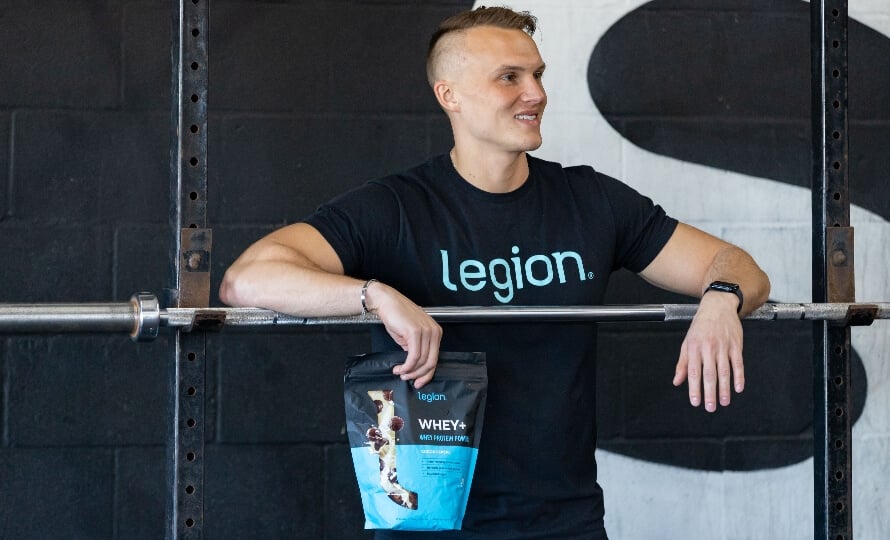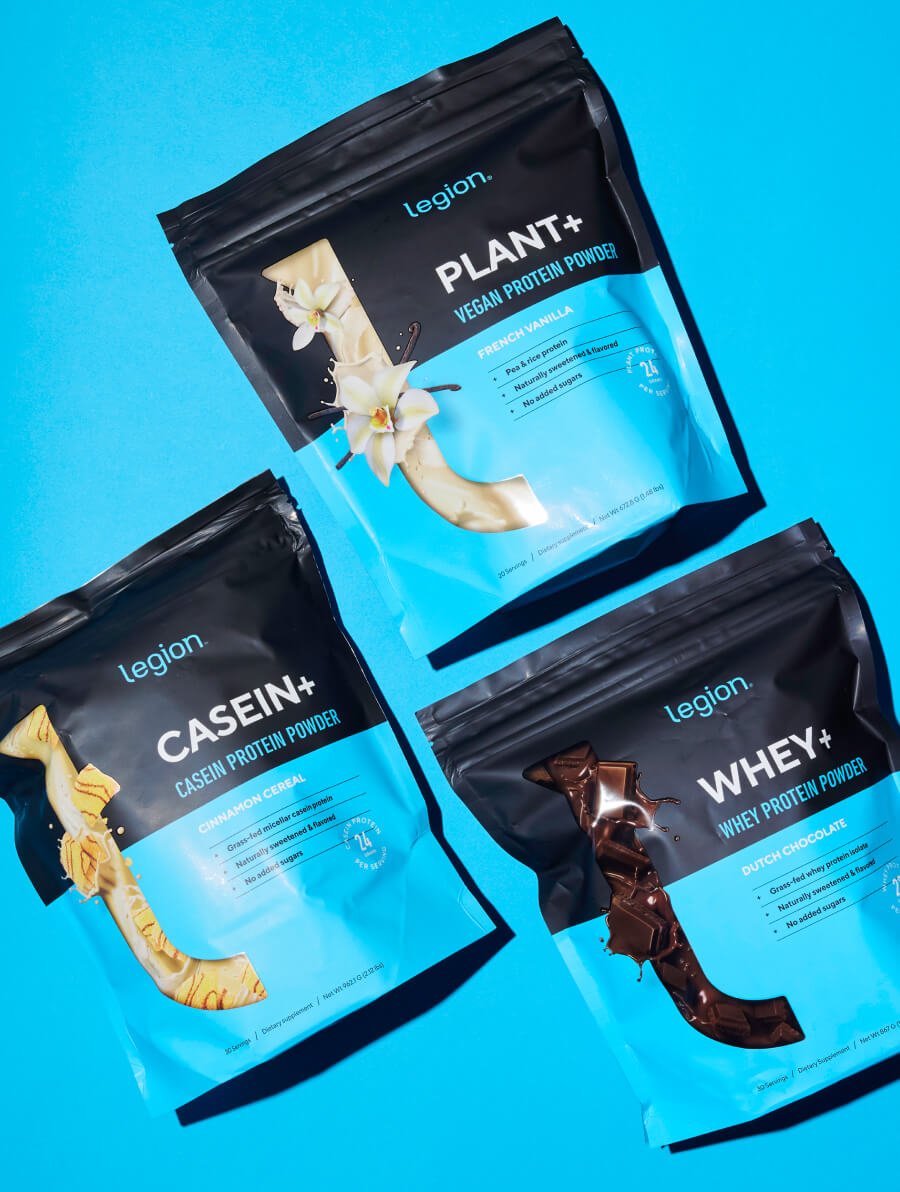Grass-fed whey is a scam—it’s nothing more than a fancy label that gives companies an excuse to charge more.
At least, that’s what some armchair nutritionists claim.
Many others swear that’s dead wrong, though.
They argue grass-fed whey protein is better than regular forms because it’s produced using more natural farming methods, which makes for nutritionally superior milk.
Who’s right?
Is grass-fed whey protein really better than regular whey?
Or is it just clever marketing?
Get evidence-based answers in this article.
Key Takeaways
- Grass-fed whey protein isn’t inherently “better” than regular whey—both are excellent sources of protein with comparable amino acid profiles.
- Nutritional advantages of grass-fed milk (like more omega-3s, CLA, and vitamins) mostly disappear when the fat is removed during processing.
- Flavor differences between grass-fed and regular dairy are usually masked once the whey is turned into protein powder and flavored.
- Where grass-fed whey protein is better than regular whey is in its production. Certified programs have higher standards for animal welfare, responsible farming, and quality control.
- If you want a whey protein powder that’s genuinely grass-fed, responsibly made, and independently tested, try Whey+.
Table of Contents
+
Grass-Fed Whey vs. Regular Whey: At a Glance
If you’re just looking for a quick breakdown of how grass-fed whey compares to regular whey, here’s a snapshot:
(We’ll explain what these differences mean—and which ones actually matter—below.)
Grass-Fed vs. Regular Whey Protein: Quick Comparison
| Feature | Certified Grass-Fed Whey | Regular Whey |
|---|---|---|
| Protein quality | ✔ Complete protein with all essential amino acids | ✔ Complete protein with all essential amino acids |
| Healthy fats (omega-3, CLA) | ↑ Higher at the source, but mostly removed during processing | ↓ Lower at the source, also removed during processing |
| Vitamins and antioxidants | ↑ Higher at the source, but mostly lost when fat is removed | ↓ Lower at the source, also lost when fat is removed |
| Taste and texture | ↑ Naturally creamier, but usually masked in flavored powders | ↓ Naturally milder, also masked in powders |
| Animal welfare | ✔ Better in certified programs | ✘ Varies—often industrial conditions |
| Hormones and antibiotics | ✔ Not allowed in certified programs | ✘ Often used unless stated otherwise |
| Label accuracy | ✔ Certified and traceable | ✘ Sourcing often unclear |
| Price | ↑ Higher due to better sourcing and standards | ↓ Lower due to conventional production |

What’s the Difference Between Grass-Fed Whey and Regular Whey?
The fundamental difference between grass-fed and regular whey is the diet of the cows that provide the milk: grass-fed whey comes from milk produced by cows that graze primarily on grass, while regular whey usually comes from cows fed a mix of grains, corn, and other roughage.
These differences influence several aspects of the resulting whey.
For instance, research shows that grass-fed dairy contains significantly more “healthy” fats, including omega-3 fatty acids, conjugated linoleic acid (CLA), and vaccenic acid, as well as a better omega-6 to omega-3 ratio compared to regular dairy.
Studies show grass-fed milk also tends to be richer in micronutrients and antioxidants, including vitamin A, vitamin E, and carotenoids like β-carotene and lutein.
What’s more, research suggests that grass-fed dairy typically has a creamier taste and texture, whereas dairy from grain-fed cows is usually sweeter and milder.
Is Grass-Fed Whey Protein Better than Regular Whey?
No, grass-fed whey protein isn’t better than regular whey.
At least, not in the ways most people think.
Whey is an excellent protein source, and gram-for-gram the protein in grass-fed whey protein powder isn’t superior to the protein in regular whey powder. In other words, your gains and recovery don’t hinge on whether the cows producing your protein powder ate grass or corn.
The higher healthy fat content of grass-fed whey probably isn’t much of an advantage, either.
Most whey protein powders—especially isolates—contain very little fat. So while you might get trace amounts of these compounds in each serving, it’s probably not enough to meaningfully benefit your health.
What’s more, most of the extra vitamins and antioxidants in grass-fed dairy are fat-soluble (carried and stored in fat), which means they’re stripped out during processing along with the fat.
And while grass-fed milk may naturally have a creamier taste, flavorings usually mask this by the time it’s turned into whey protein powder.
Where grass-fed whey protein is better than regular whey is in its production.
The best grass-fed whey comes from certified programs like Truly Grass Fed™, the American Grassfed Association (AGA), or Pasture for Life.
These initiatives require cows to spend more time on pasture, eat a more natural diet, and live in less industrial conditions, which often leads to better animal welfare, more responsible farming, and higher-quality milk overall.
Certified programs typically follow stricter medical guidelines, too. For instance, they usually ban the use of growth hormones such as recombinant bovine somatotropin (rBST), which prevent these compounds from making it into grass-fed dairy.
Likewise, they more tightly control antibiotic use. While unwell animals may receive medicine, the milk from those animals can’t reenter the supply chain until tests show it’s clean.
There’s also the matter of quality control. Certified grass-fed whey comes from audited supply chains where independent inspectors trace the milk through the entire production process and test the final product to ensure it’s clean and consistent.
One Big Problem with Grass-Fed Whey Protein Powder
The biggest problem with grass-fed whey protein powder is honesty. “Grass-fed” isn’t a regulated term, so companies can slap it on a label without offering a shred of proof that it’s true.
For example, a cow might graze occasionally on pasture but spend most of its life eating grain, yet companies can—and often do—market the whey as “100% grass-fed.”
That’s why you shouldn’t take the claim at face value.
How can you avoid getting misled?
Three ways: certification, sourcing, and transparency.
That is, if a brand doesn’t use certified whey, won’t explain how its whey is produced, or doesn’t routinely test its products in third-party labs, assume the grass-fed label is more of a marketing ploy than reality.
To learn more about the grass-fed whey “scam,” check out this article:
Is Grass-Fed Whey Protein Powder a Scam?
Are There Any Other Downsides to Grass-Fed Whey Protein?
The only real downside is price. Grass-fed whey protein costs more to produce—it typically comes from smaller farms that have stricter standards and submit their products to independent testing—and that makes the final product more expensive.
Whether that’s worth it depends on your priorities.
Beyond that, there aren’t any real drawbacks.
Grass-fed whey isn’t harder to digest than regular whey, and it isn’t less effective for building muscle or aiding recovery. It’s still whey, after all.
If there’s a catch, it’s the label itself. As we’ve already discussed, many products that claim to be grass-fed offer little or no proof. So the issue isn’t the whey—it’s making sure the product you’re buying is actually what it claims to be.
What’s the Best Grass-Fed Whey Protein Powder?
Whey+ is a whey protein isolate powder made with antibiotic- and hormone-free Truly Grass Fed™ milk.
It comes from small Irish dairy farms certified by Ireland’s Sustainable Dairy Assurance Scheme, which ensures the farmers adhere to best practices in animal welfare, sustainability, product quality, traceability, and soil and grass management.
Whey+ also contains no artificial sweeteners, flavors, food dyes, fillers, or other unnecessary junk. And it’s lab-tested for purity and accuracy and independently certified by Labdoor™ to meet or exceed FDA and WADA safety guidelines.
In other words, if you want a whey protein powder that’s genuinely grass-fed, responsibly made, and independently tested, try Whey+.
The Bottom Line on Whether Grass-Fed Whey Is Better Than Regular Whey
While many “nutrition gurus” say grass-fed whey is a healthier choice, research doesn’t really bear that out.
Grass-fed milk—the base ingredient for grass-fed whey—does have more healthy fats and vitamins, but most of these are lost when the milk is processed into powder.
That means grass-fed whey isn’t nutritionally superior to regular whey—both provide the same high-quality protein your body needs to build muscle, recover, and stay healthy.
Where grass-fed whey does have an edge is in how it’s produced: certified programs uphold higher standards for animal welfare, sustainable farming, and product quality.
The problem is that “grass-fed” isn’t a regulated term, so many products use it loosely or without proof.
For a whey protein powder that’s genuinely grass-fed, responsibly made, and independently tested, try Whey+.
FAQ #1: How does grass-fed whey affect gut health?
Many people think grass-fed whey is better for gut health because grass-fed milk contains more CLA, a fatty acid with anti-inflammatory properties that may support gut function.
However, most of that CLA is removed when the milk is processed into whey protein powder, so the difference is minimal.
Another common belief is that grass-fed whey causes less bloating or stomach discomfort. That can be true—but mainly because many grass-fed products are also whey isolates, which contain very little lactose and are easier to digest for people sensitive to dairy.
FAQ #2: Does it matter if protein powder is grass-fed?
Not for muscle gain or recovery—grass-fed and regular whey both provide the same high-quality protein.
It only matters if you care about things like animal welfare, cleaner sourcing, or transparency. In that case, certified grass-fed products are usually a better choice.
FAQ #3: Is grass-fed whey inflammatory?
No. Research shows that whey protein—whether grass-fed or not—doesn’t appear to be inflammatory. In fact, studies show that supplementing with whey protein powder may even reduce inflammation in some cases.
FAQ #4: Grass-fed whey vs. Whey isolate: Which is better?
Neither is strictly better—they’re just different.
“Grass-fed” refers to how the cows are raised, what they eat, and usually means the product was made more responsibly and transparently. “Isolate” tells you a product was processed to remove most of the fat and carbs.
When choosing a protein powder, pick whichever matters most to you. Or if you want both, try a grass-fed isolate, like Whey+.
Want More Content Like This?
Check out these articles:
- The Ultimate Guide to the Best Protein Powders: Whey, Casein, Egg, Soy, and More…
- Casein vs. Whey: Which Is Better for Building Muscle?
- When Is the Best Time to Drink a Protein Shake?
- What’s the Best Protein Powder for Weight Loss?
- Is Eating Too Much Protein Powder Unhealthy?
Scientific References +
- Alothman, Mohammad, et al. “The “Grass-Fed” Milk Story: Understanding the Impact of Pasture Feeding on the Composition and Quality of Bovine Milk.” Foods, vol. 8, no. 8, 17 Aug. 2019, p. 350, https://doi.org/10.3390/foods8080350. Accessed 30 Sept. 2020.
- Benbrook, Charles M., et al. “Enhancing the Fatty Acid Profile of Milk through Forage-Based Rations, with Nutrition Modeling of Diet Outcomes.” Food Science & Nutrition, vol. 6, no. 3, 28 Feb. 2018, pp. 681–700, https://doi.org/10.1002/fsn3.610. Accessed 11 Sept. 2020.
- Șanta, Anita, et al. “The Effect of Sustainable Feeding Systems, Combining Total Mixed Rations and Pasture, on Milk Fatty Acid Composition and Antioxidant Capacity in Jersey Dairy Cows.” Animals, vol. 12, no. 7, 1 Apr. 2022, pp. 908–908, www.ncbi.nlm.nih.gov/pmc/articles/PMC8997149/, https://doi.org/10.3390/ani12070908. Accessed 16 May 2024.
- Faccia, Michele. “The Flavor of Dairy Products from Grass-Fed Cows.” Foods, vol. 9, no. 9, 27 Aug. 2020, p. 1188, https://doi.org/10.3390/foods9091188. Accessed 20 Sept. 2020.
- Barenie, Matthew J, et al. “Grass-Fed and Non-Grass-Fed Whey Protein Consumption Do Not Attenuate Exercise-Induced Muscle Damage and Soreness in Resistance-Trained Individuals: A Randomized, Placebo-Controlled Trial.” Journal of Dietary Supplements, 20 Nov. 2023, pp. 1–30, https://doi.org/10.1080/19390211.2023.2282470. Accessed 1 Apr. 2024.
- Lindmark Månsson, Helena. “Fatty Acids in Bovine Milk Fat.” Food & Nutrition Research, vol. 52, no. 1, Jan. 2008, p. 1821, https://doi.org/10.3402/fnr.v52i0.1821.
- More, SJ. “Global Trends in Milk Quality: Implications for the Irish Dairy Industry.” Irish Veterinary Journal, vol. 62, no. S4, 1 Apr. 2009, www.ncbi.nlm.nih.gov/pmc/articles/PMC3339351/, https://doi.org/10.1186/2046-0481-62-s4-s5.
- Archer, Simon C., et al. “Association of Season and Herd Size with Somatic Cell Count for Cows in Irish, English, and Welsh Dairy Herds.” The Veterinary Journal, vol. 196, no. 3, June 2013, pp. 515–521, https://doi.org/10.1016/j.tvjl.2012.12.004.
- O’Brien, B., et al. “Irish Research Response to Dairy Quality in an Era of Change.” Irish Journal of Agricultural and Food Research, 26 Feb. 2022, https://doi.org/10.15212/ijafr-2020-0142.
- Fatemeh Farahmandpour, et al. “Whey Protein Intervention and Inflammatory Factors and Oxidative Stress: Systematic Review and Meta-Analysis of Randomized Controlled Trials.” Nutrition Reviews, 28 Aug. 2024, academic.oup.com/nutritionreviews/advance-article-abstract/doi/10.1093/nutrit/nuae100/7743251?redirectedFrom=fulltext, https://doi.org/10.1093/nutrit/nuae100. Accessed 16 Nov. 2024.
- Prokopidis, Konstantinos, et al. “Effects of Whey and Soy Protein Supplementation on Inflammatory Cytokines in Older Adults: A Systematic Review and Meta-Analysis.” British Journal of Nutrition, vol. 129, no. 5, 16 June 2022, pp. 1–12, https://doi.org/10.1017/s0007114522001787.















